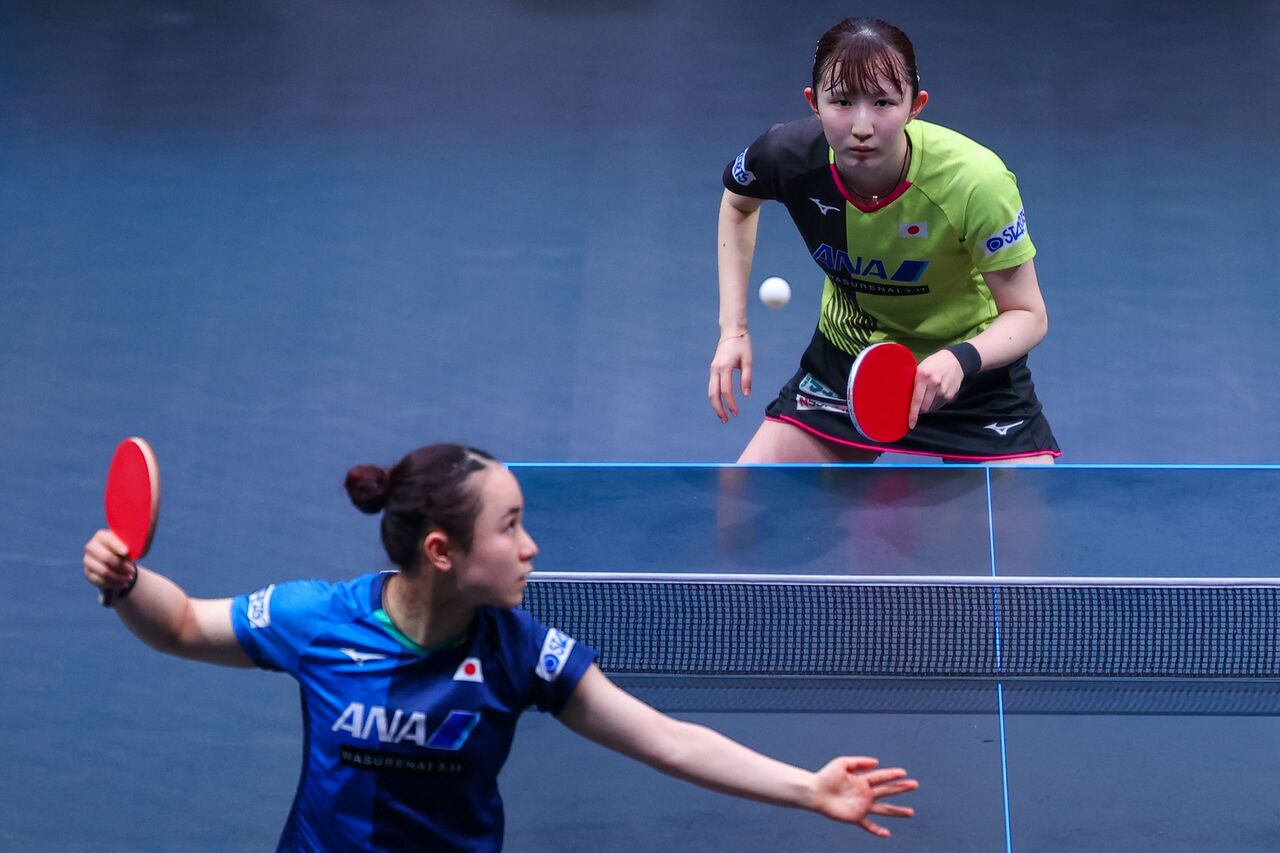The Business of Sport: Table tennis industry is worth billions, says WTT chief Dainton
Sign up now: Get the biggest sports news in your inbox

Japan's Hina Hayata (right) competes with Japan's Mima Ito during the finals of the women's singles of the World Table Tennis (WTT) Middle East Hub in the Qatari capital Doha, on March 6, 2021.
PHOTO: AFP
Follow topic:
SINGAPORE - With 226 member associations within the International Table Tennis Federation (ITTF), hundreds of millions of people playing the sport worldwide, and five continents represented in the top 50 of both the men's and women's world rankings, table tennis can be considered a truly global sport.
This is why ITTF chief executive Steve Dainton estimates the table tennis industry is worth "billions of dollars" and this untapped potential is also the reason the world governing body created and launched its new commercial vehicle World Table Tennis (WTT) last year.
The Australian told The Straits Times: "Our industry is huge, there are hobby players all over the world who follow the scene... for sure the potential is in the billions of dollars and we are really only scraping at the surface with our current business model."
Studying how other sports like badminton, darts and volleyball have progressed in terms of having major events, glitzy event production, bigger prize purses and better player services, Dainton and his team took a few years to analyse various models before settling on the WTT.
It also signed a long-term partnership with sports and event management company IMG to produce WTT events, develop and distribute media and streaming rights and betting data, and further grow the sport.
Dainton, who is also WTT director, said: "We were looking at many of those sports and asking ourselves, 'If they are going that much faster than us, why are we not keeping up with them?'
"And once we did the comparisons, we had a lot of work to do."
Under WTT, a new event structure was announced in March last year that will see a total prize purse of U$13 million (S$17.4m) a year, more than double the current amount.
Modelled after tennis' Grand Slams, the top tier will comprise four US$2-3million Grand Smashes tournaments, with each 10-day event featuring 64 men's and women's singles players in the main draw, as well as doubles competitions.
There will be three other tiers under the WTT series. These include the US$1-US$1.5 million WTT Cup Finals featuring the top 16 men and women players. There is also the US$400,000-US$600,000 WTT Champion Series, which includes four male and female events for the 32 highest-ranked paddlers.
Lower-ranked and up-and-coming players can compete in the US$50,000-US$300,000 WTT Contender series, which is split into the Star Contenders and Contenders competitions, which allows for more qualifiers.
Despite the ongoing coronavirus pandemic that has wreaked havoc on global sports scheduling, WTT has pressed on. A showcase event was held in Macau last November, while one Contender and one Star Contender event took place successfully in the Qatar hub in March.
A China hub comprising back-to-back events has been planned after the Tokyo Olympics conclude in August, while there are also talks to have a Grand Smash event in Singapore in 2022.
Dainton said: "We were planning to have 35 to 40 events, but with Covid-19, we would be happy to have 10 to 15.

"Sport has to survive and prevail. At some stage, the pandemic will end and we want to be on the front foot showing that even during that difficult time we still had content and our best players competing, and we are still moving forward with our plan in a safe setting."
The returns may not be immediate as official viewership figures are not in yet and WTT is still building up its sponsor pool, which means it has to dig into its reserves first.
Dainton shared that the cost of the Doha bubble, which includes around 6,000 tests for about 150 people and other Covid-19 preventive measures, was about US$1-2 million.
The prize money for the Contender event was also doubled to US$200,000 as a sign of solidarity with the players who have had to cope without being able to challenge for prize money for most of the year.
And this comes at a time when his 15-strong WTT team are at half-strength and have taken a 30-40 per cent pay cut during this downtime.
"Even if it represents an initial investment from us now, we think it's better to try and move on and weather the storm," said Dainton.
He also had to deal with opposition from within the ITTF, with some European associations such as the Germans raising concerns over WTT's governance and accountability last November.
Dainton said such sentiments are understandable and it will do its best to convince the critics that the entire table tennis family will stand to gain if WTT is successful.
He said: "Inside a federation like ours which is 95 years old, where we have had a system for a long time, any major transformation is always going to be hard to accept for some. We try to take it in our stride and see it as there are things that we could improve on and communicate better as well.
"In many sports including us, due to the commercial and financial nature, there is so much more attention on the elite level.
"And when you put the attention only on the elite, hundreds of players behind will be frustrated. They want to also participate but there are not that many events for them because it probably doesn't make as much financial sense to have them.
"This is what we are trying to change by having more tiers and events. The business and financial side of sport are important, but we believe that as WTT takes off, the entire family - member associations, players and partners - can all benefit together."

